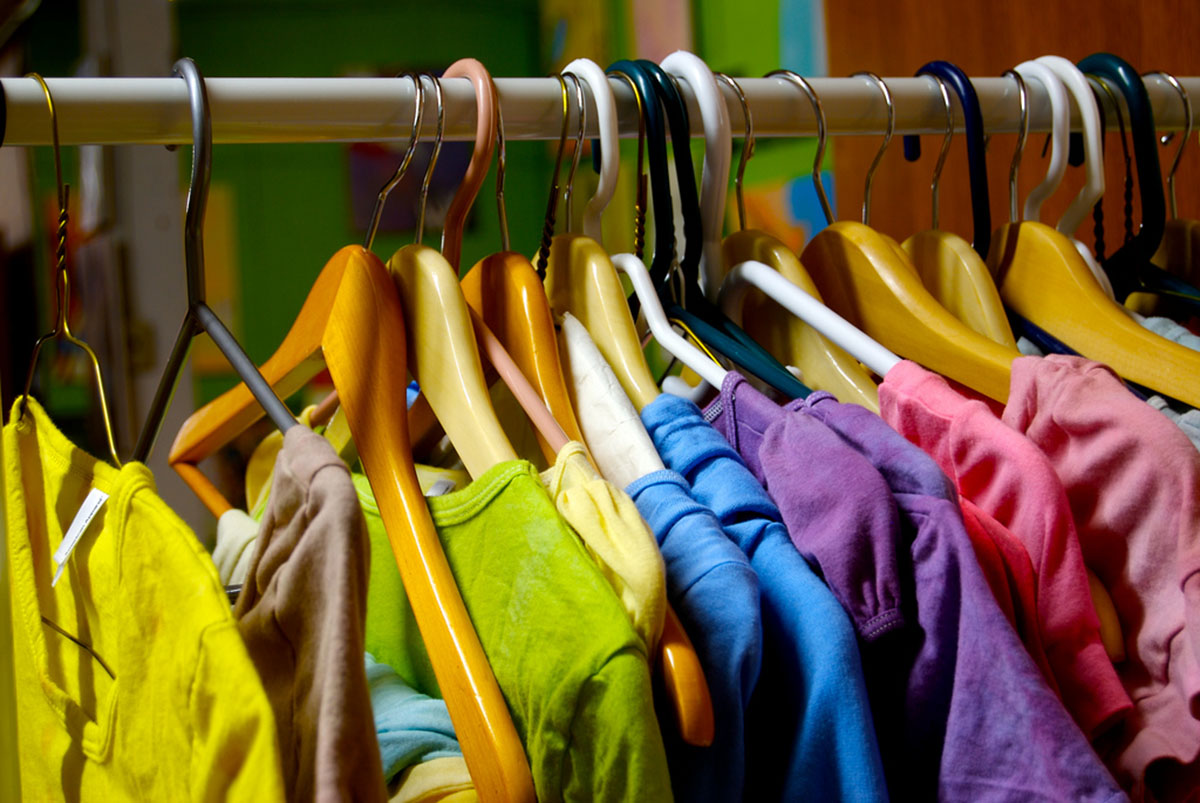Having grown up in the 1950's, I am a big fan of wash and wear clothing.
Back in the days when most of us still wore natural fabrics (polyester and nylon had been invented but they looked cheap), first you'd have to put your clothes in the washer with a complicated regimen of detergent and "bluing" to make whites whiter. Then, because you didn't have a clothes dryer, you would have to hang your clothes on a clothesline and let them dry in the sun, hoping it didn't rain, no birds passed overhead, there wasn't a sudden dust storm, and your neighbors didn't help themselves. Next you would have a pile of laundry to iron. You'd have to use a deft touch to make sure your iron didn't stick and scorch your clothes but it was hot enough to smooth out all the wrinkles.

Wrinkle-Free Clothing Has Improved Over the Years
Wash and wear clothing was actually introduced by Brooks Brothers in 1953, but it didn't really become popular until the early 1990's. There was a problem with yellowing and with odor, which might not be especially hard to understand if you knew that one of the chemicals added to cloth to make it wrinkle-free was and is a form of urea. There was a problem with chafing and irritation, especially under the arms and anywhere clothing fit tightly. This was due to the fact that the other chemical used to make clothing wrinkle-free was and is a form of formaldehyde. One of the earliest formaldehyde uses was to make expensive wrinkle-free fabrics, as early as 1926.
Wrinkle-Free Clothing May Cause Eczema
In the 1970's and 1980's, most people were so happy not have to spend weeknights and weekends over an ironing board (or having to pay the cleaners to clean and press clothes), that they just put up with the underarm irritation and general itchiness of wash-and-wear wrinkle-free permanent press clothes. By 2011, however, chemical sensitivity to the ethylene urea and melamine formaldehyde used in combat uniforms even became a minor national security issue. At least one soldier was taken out of a combat role after developing a severe allergy to the military uniform.
Just how common is dermatitis caused by wrinkle-free fabric? One small study found that 11 out of 17 eczema patients were sensitive to the formaldehyde resin used in permanent press clothes. Fortunately, there is a simple way to deal with the problem.
READ Dangerous and Toxic Chemicals Found in Cosmetic Products: Their Impact on the Human Body
- Wash your wash-and-wear before you wear it. Consumer Affairs New Zealand advises washing new wash-and-wear clothes twice before putting them on, drying them outside at least once if possible.
- Natural fabrics (cotton, linen, hemp, and wool) are less likely to cause allergic reactions than synthetic fabrics, but they are more likely to harbor lice and mites left by other customers who tried them on. It is important to wash and dry natural fabrics in a clothes dryer at least once to kill tiny hitchhikers.
- Fabrics marked dry-clean only should be allowed to air out before they are used.
Some clothing, however, is less toxic than others, as we'll see on the next page.
How To Buy Non-Toxic Clothing
If you have a chronic problem with skin irritation, especially under the arms, on the shoulders, and just above the waistline, the solution may be to buy cotton. Cotton is far less likely to cause skin irritation than synthetic fabrics:
- Nylon isn't a particularly problematic artificial fabric, but it can cause problems if it is given a finish to make it wash-and-wear.
- Rayon is made from wood pulp and lint, and has to be treated with heavy amounts of chemicals to keep it from falling apart.
- Spandex and Lycra are tolerable in small amounts in stretch fabrics, although anything made with more than 10 percent of either material is likely to cause redness, chafing, and irritation.
- Polyester is an especially irritating fabric, made from esters of dihydric alcohol and terephthalic acid, both of which irritate the skin, regardless of whether any other chemicals are added.
- Silk is a natural fabric, but it naturally carries a positive charge, which binds chemicals to the fabric. Some garment makers wash imported silk in Bounce fabric softener.
- Linen is not particularly problematic, but it's also not widely available for clothing.

The best fabric option for most people is high-quality cotton. Cotton is a natural plant fiber that doesn't carry an electrical charge, so it does not attract chemicals. Cotton on your body is soft, durable, comfortable, and washable. Cotton on kids reduces risk of eczema and atopic dermatitis. Although organic cotton is available in the United States, the crop tends to be heavily sprayed while it is still in the fields. Fortunately, agricultural chemicals in cotton mostly wash out. However, there are choices of cotton and methods of manufacturing cotton that make clothing less toxic.
- Long-staple Egyptian or Pima (Arizona) cotton has a naturally silky feel and doesn't have to be treated with chemicals to feel soft. Cheaper cotton fabrics common in the US are made with short-staple cotton that has to be chemically treated. Expensive cotton fabrics common in the EU are made with long-staple product.
- If you want to make sure you get cotton that is free of formaldehyde, look for "garment-dyed" cotton clothing. Cotton can be dyed when it is still yarn. In the United States, cotton is usually died as fabric before it is cut and sewed into clothes. If the cloth has already been dyed before it is sewed, it can be treated with a formaldehyde-based finish to make sure it doesn't wrinkle. If the clothing is dyed only after it has been sewed together, that is, it is "garment-dyed," it cannot be treated with a formaldehyde finish. This doesn't mean it will be absolutely chemical free, but the only residual chemicals present in garment-dyed clothing are likely to be those used in laundering it before it left the factory.
What else can you do to avoid toxic buildup in clothing? Most of the time it's best to wash in cold water and dry on the line. Heat causes chemical reactions and the release of chemicals from fabric. If lice, mites, or bedbugs are a problem, however, clothes should be dried in the clothes dryer. It's also best not to dry clothes on the line outdoors during pollen season.
READ Laundry Bacteria In Your In Your 'Clean' Clothes: Are You Using The Sick Laundry Cycle?
If ironing seems to set off allergies, the problem may be a sealant in the water chamber in the iron. Norelco and Sunbream brand irons don't use this sealant. You may also want to replace your commercial ironing board cover with flannel secured by paper tape. The best ironing board is covered with an organic fabric.
- Aldrich SL, Murchland MR, Henning JS. Permanent press allergy in an active duty U.S. Army soldier. Mil Med. 2011 May.176(5):584-5.
- Fowler JF Jr, Skinner SM, Belsito DV. Allergic contact dermatitis from formaldehyde resins in permanent press clothing: an underdiagnosed cause of generalized dermatitis. J Am Acad Dermatol. 1992 Dec. 27(6 Pt 1):962-8.
- Photo courtesy of featheredtar: www.flickr.com/photos/featheredtar/2298993649/
- Photo courtesy of featheredtar: www.flickr.com/photos/featheredtar/2298993649/
- Photo courtesy of epsos: www.flickr.com/photos/epsos/4444576795/


Your thoughts on this